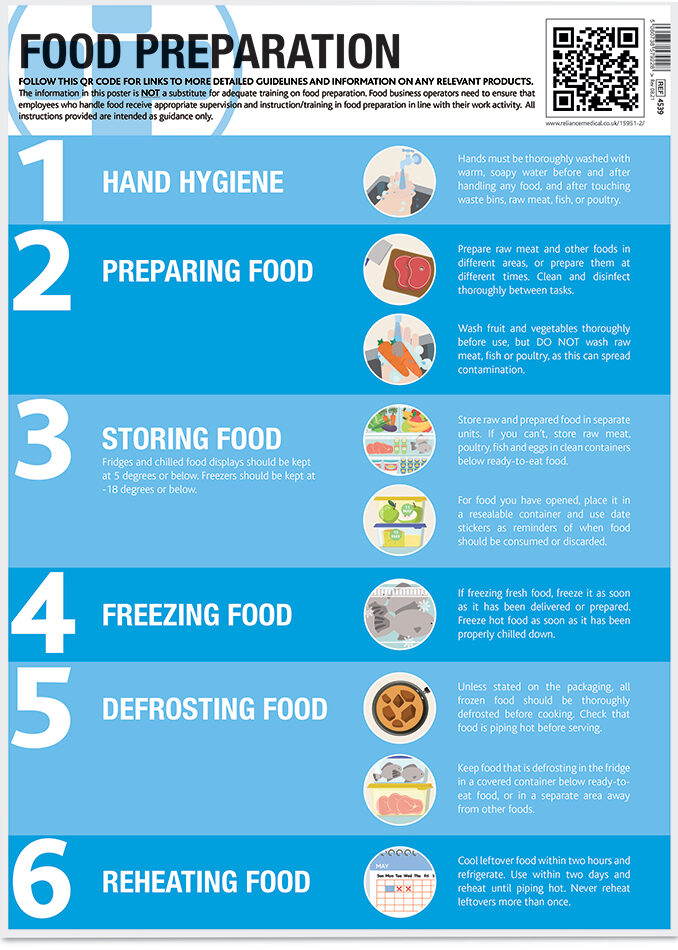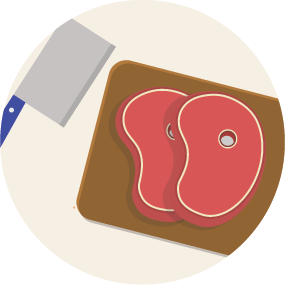
CROSS CONTAMINATION
Cross-contamination occurs when bacteria is spread between food, surfaces, or equipment.
RAW FOOD
It is most likely to happen when raw food touches or drips onto ready-to-eat food, equipment or surfaces. For example, if raw meat drips onto a cake in the fridge, bacteria will spread from the meat to the cake.
EQUIPMENT
It can also happen when you use the same equipment for raw and ready-to-eat food. For example, if you cut raw chicken on a chopping board, bacteria will spread from the chicken to the board and knife. If you later use the same board and knife to chop a cucumber without washing and disinfecting them first, the bacteria will spread from the board and knife to the cucumber.
HANDS
Hands can also spread bacteria. If you do not wash your hands thoroughly after touching raw food, you can spread bacteria to the other things you touch. Cross-contamination is one of the most common causes of food poisoning.
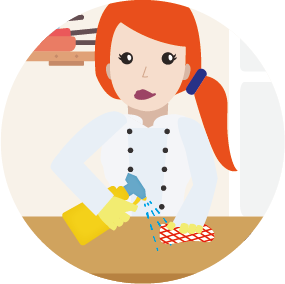
PREVENTING CROSS-CONTAMINATION
You must ensure that work areas, surfaces, and other equipment used for raw and ready-to-eat food, are adequately separated. To avoid cross-contamination you should also:
Clean and disinfect work surfaces, chopping boards, and equipment thoroughly before you start preparing food and after you have used them to prepare raw food.
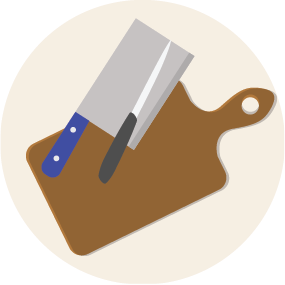
Use different equipment (including chopping boards and knives), for raw meat, poultry, and ready-to-eat food unless they can be disinfected by heat, for example, in a commercial dishwasher.
Use separate machinery and equipment, (such as vacuum packing machines, slicers, and mincers), for raw and ready-to-eat food, or ensure they are thoroughly disinfected between uses.

Wash your hands thoroughly before preparing food and after touching raw food.
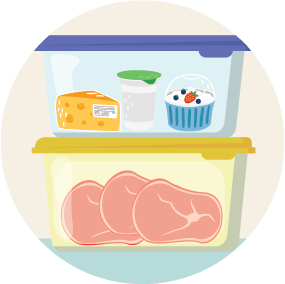
Always keep raw and ready-to-eat food separate, including packaging material for ready-to-eat food.
In the fridge, always store raw food below ready-to-eat food. If possible, use separate fridges for raw and ready-to-eat food.
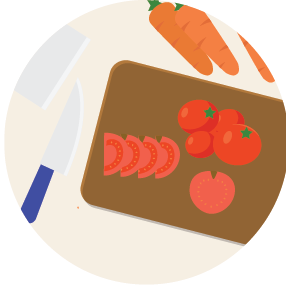
Provide separate food preparation areas, storage facilities, clothing, and staff for the handling of ready-to-eat food.
If raw and ready-to-eat food need to be handled in the same preparation area, ensure the area is thoroughly disinfected between these uses.

Use separate cleaning materials, including cloths, sponges, and mops in areas where ready-to-eat foods are stored, handled, or prepared.
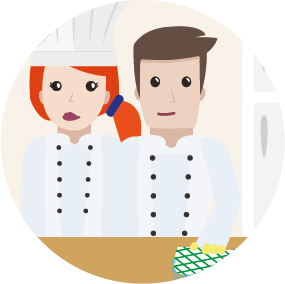
Make sure that your staff know how to avoid cross-contamination.
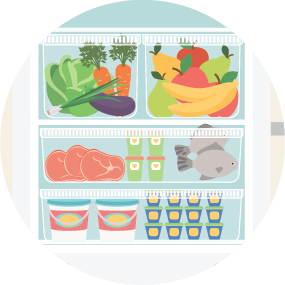
STORING FOOD
CHILLING
Chilling food properly helps to stop harmful bacteria from growing. Some foods need to be kept chilled to keep them safe, for example:
• Food with a use-by date.
• Cooked dishes.
• Other ready-to-eat food, such as prepared salads and desserts.
It is very important not to leave these types of food standing around at room temperature. Make sure that you:
• Follow storage instructions.
• Put food that needs to be chilled in the fridge straight away.
• Cool cooked food as quickly as possible and then put it in the fridge.
• Keep chilled food out of the fridge for the shortest time possible during preparation.
• Check regularly that your fridge and display units are cold enough.
Whenever you are serving or displaying cold foods, they can be kept outside the fridge for up to four hours. If any food is left after this time, you should throw it away. Do not return it to the fridge.
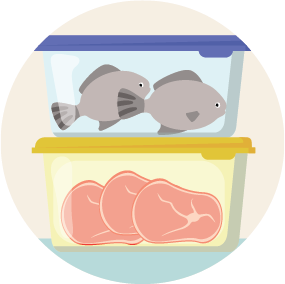
FRIDGE TEMPERATURE
Cold food must be kept at 8˚C or below. This is a legal requirement in England, Wales, and Northern Ireland.
In practice, it is recommended that you set your fridge at 5˚C to make sure that food is kept cold enough.
Check regularly that your fridge and any display units are cold enough.
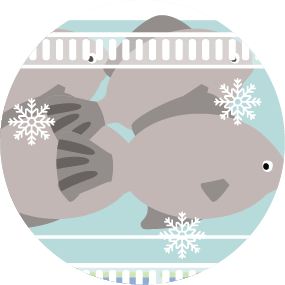
FREEZING & DEFROSTING
It is important to take care when freezing food. To handle frozen food safely, you should:
• Put frozen food in the freezer as soon as it is delivered.
• When freezing fresh food, place it in the freezer as soon as it has been delivered or prepared.
• Divide food into smaller portions and put it in containers or freezer bags before freezing.
• If you freeze food that has a ‘use-by’ date, make sure you freeze it before the use-by date has passed and clearly note the date you are freezing it. You will also need to change the original ‘use-by’ date to a ‘best before’ date.
Ideally, you should defrost food in the fridge. Putting food in the fridge will keep it at a safe temperature while it is defrosting. If you cannot defrost food in the fridge, you could put it in a container and then place it under cold running water. Raw meat and poultry, (including large joints and whole birds), should not be defrosted under cold running water unless they are in a sealed container. You could also defrost food in the microwave by using the ‘defrost’ setting.
Food should be thoroughly defrosted before cooking unless the manufacturer’s instructions tell you to cook from frozen.
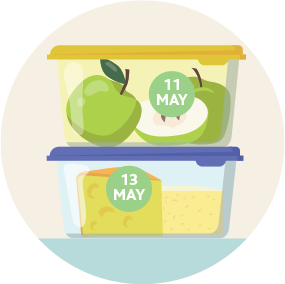
FOOD STORAGE
Food may contain bacteria, and if stored for too long or at the wrong temperature, it can cause food poisoning. It is important to understand the different types of dates and advice on food packaging. Depending on the product, you will see one of the following two dates on most packaged foods:
• A ‘use-by’ date – relating to food safety
• A ‘best before date’ – relating to food quality
A use-by date on food is about safety; this is the most important date to remember.
You can eat food until and on the use-by date but not after. You will see use-by dates on food that goes off quickly, such as meat products or ready-to-eat salads. For the use-by date to be a valid guide, you must carefully follow
storage instructions. For example, if the instructions on the packaging tell you to refrigerate after opening, you should keep the food in a fridge at 5°C or below. Don’t eat, cook, or freeze your food after the use-by date; it could
be unsafe to eat or drink, even if it has been stored correctly and looks and smells fine. Place food you have already opened in a resealable container and use date stickers as reminders of when that food should be consumed or discarded.
The best before date, sometimes shown as BBE (best before end), is about quality and not safety.
The food will be safe to eat after this date but may not be at its best. Its flavour and texture might not be as good. Best before dates appear on a wide range of foods including:
• Frozen foods (such as peas, chips and ice cream)
• Dried foods (such as pasta and rice)
• Tinned foods (such as baked beans and canned tomatoes)
The best before date will only be accurate if the food is stored according to the instructions on the packaging.
Food Preparation Quiz
A short quiz to test your knowledge of Food Preparation and Storage.

All information is for guidance only and correct at time of publication.


